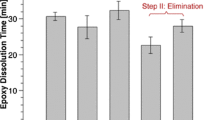Abstract
A novel method was proposed for recycling the composites by thermal excitation oxide semiconductors. The decomposition ability of TiO2 and Cr2O3 was investigated based on analysis of effects of the temperature and time on decomposition rate of the epoxy resin. The microstructure, graphitization degree and mechanical properties of the recycled carbon fiber were investigated, and the effects of O2 on the decomposition were analyzed. The results indicated that TiO2 and Cr2O3 had excellent decomposition ability on CF/EP composites at 350–500°C; Cr2O3 was more suitable to decompose composites due to its high purity and good thermal stability against TiO2; the temperature and time were positively correlated with the decomposition rate of epoxy resin, and the influence intensity of the temperature was higher than that of the time; O2 could promote recycling by oxidation of the carbon deposit and supporting combustion, and the IG/ID of the recycled carbon fiber was significantly lower than that of original carbon fiber; the monofilament tensile strength of the recycled carbon fiber was 87% of that of the original carbon fiber at 500°C, 15 min and the flow rate of 100 ml/min (99.999% O2).
Similar content being viewed by others
References
J. Yang, J. Liu, W. B. Liu, J. Wang, and T. Tang, J. Anal. Appl. Pyrol., 112, 253 (2015).
X. Li, R. B. Bai, and M. K. Jon, J. Clean. Prod., 127, 7 (2016).
M. J. Keith, G. Oliveux, G. A. Leeke, O. Geraldine, and A. L. Gary, ECCM17-17th European Conference on Composite Materials, pp. 1–7, Munich, Germany, 2016.
H. H. Huang, Z. P. Zhao, and H. B. Cheng, Acta Materiae Compositae Sinica, 8, 1621 (2016).
I. Okajima and T. Sako, J. Mater. Cycles. Waste., 19, 15 (2017).
S. H. Lee, H. O. Choi, J. S. Kim, and C. S. Ju, Korean J. Chem. Eng., 28, 449 (2011).
H. B. Cheng, H. H. Huang, J. Zhang, and D. Q. Jing, Fiber. Polym., 18, 795 (2017).
H. F. Sun, G. P. Guo, S. A. Memon, W. T. Xu, Q. W. Zhang, J. H. Zhu, and F. Xing, Compos. Part A-Appl. S., 18, 11 (2015).
M. B. He, Z. L. Ma, and W. P. Liu, Modern Appl. Phys., 1, 48 (2016).
J. Xin, MS Thesis, BUCT, Beijing, 2017.
C. C. Song, F. Wang, Y. Liu, X. L. Wang, and B. Yang, Polym. Compos., 11, 2544 (2015).
L. Mazzocchetti, T. Benelli, E. D’Angelo, C. Leonardi, G. Zattini, and L. Giorgini, Compos. Part A-Appl. S., 112, 504 (2018).
H. L. H. Yip, S. J. Pickering, and C. D. Rudd, Plast. Rubber. Compos., 6, 278 (2002).
N. Rer, E. I. Rudolf, and K. Jan, Kunststoffe International, 6, 63 (2014).
K. W. Kim, H. M. Lee, J. H. An, D. C. Chung, K. H. An, and B. J. Kim, J. Environ. Manage., 203, 872 (2017).
G. Oliveux, L. O. Dandy, and G. A. Leeke, Prog. Mater. Sci., 72, 61 (2015).
K. Matsumoto, Y. Sato, and T. Ebara, J. Chem. Eng. Jpn., 2, 57 (2008).
S. Chen, L. H. Deng, and Q. L. Wu, Hi-Tech. Fiber. Appl., 3, 32 (2014).
Acknowledgments
This work is financially supported by the National Natural Science Foundation of China (51705237), the Natural Science Foundation of Higher Education Institutions of Jiangsu Province (17KJB460006) and the Scientific Research Fund for High-level Talents in Nanjing Institute of Technology (YKJ201601).
Author information
Authors and Affiliations
Corresponding author
Rights and permissions
About this article
Cite this article
Cheng, H., Sun, Y., Wang, X. et al. Recycling Carbon Fiber/Epoxy Resin Composites by Thermal Excitation Oxide Semiconductors. Fibers Polym 20, 760–769 (2019). https://doi.org/10.1007/s12221-019-7946-8
Received:
Revised:
Accepted:
Published:
Issue Date:
DOI: https://doi.org/10.1007/s12221-019-7946-8




